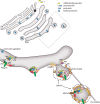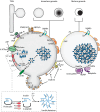Insulin granule biogenesis and exocytosis
- PMID: 33146746
- PMCID: PMC7966131
- DOI: 10.1007/s00018-020-03688-4
Insulin granule biogenesis and exocytosis
Abstract
Insulin is produced by pancreatic β-cells, and once released to the blood, the hormone stimulates glucose uptake and suppresses glucose production. Defects in both the availability and action of insulin lead to elevated plasma glucose levels and are major hallmarks of type-2 diabetes. Insulin is stored in secretory granules that form at the trans-Golgi network. The granules undergo extensive modifications en route to their release sites at the plasma membrane, including changes in both protein and lipid composition of the granule membrane and lumen. In parallel, the insulin molecules also undergo extensive modifications that render the hormone biologically active. In this review, we summarize current understanding of insulin secretory granule biogenesis, maturation, transport, docking, priming and eventual fusion with the plasma membrane. We discuss how different pools of granules form and how these pools contribute to insulin secretion under different conditions. We also highlight the role of the β-cell in the development of type-2 diabetes and discuss how dysregulation of one or several steps in the insulin granule life cycle may contribute to disease development or progression.
Keywords: Diabetes; Insulin; Lipids; β-Cell.
Figures




Similar articles
-
Deploying insulin granule-granule fusion to rescue deficient insulin secretion in diabetes.Diabetologia. 2012 Apr;55(4):877-80. doi: 10.1007/s00125-012-2483-7. Epub 2012 Feb 4. Diabetologia. 2012. PMID: 22307686
-
Mathematical modeling of insulin secretion and the role of glucose-dependent mobilization, docking, priming and fusion of insulin granules.J Theor Biol. 2013 Feb 7;318:210-25. doi: 10.1016/j.jtbi.2012.11.002. Epub 2012 Nov 12. J Theor Biol. 2013. PMID: 23154190 Free PMC article.
-
Kv2.1 Clustering Contributes to Insulin Exocytosis and Rescues Human β-Cell Dysfunction.Diabetes. 2017 Jul;66(7):1890-1900. doi: 10.2337/db16-1170. Epub 2017 Jun 12. Diabetes. 2017. PMID: 28607108 Free PMC article.
-
Recent new insights into the role of SNARE and associated proteins in insulin granule exocytosis.Diabetes Obes Metab. 2017 Sep;19 Suppl 1:115-123. doi: 10.1111/dom.13001. Diabetes Obes Metab. 2017. PMID: 28880475 Review.
-
Insulin granule biogenesis, trafficking and exocytosis.Vitam Horm. 2009;80:473-506. doi: 10.1016/S0083-6729(08)00616-X. Vitam Horm. 2009. PMID: 19251047 Free PMC article. Review.
Cited by
-
Peptide Inhibitors of Insulin Fibrillation: Current and Future Challenges.Int J Mol Sci. 2023 Jan 9;24(2):1306. doi: 10.3390/ijms24021306. Int J Mol Sci. 2023. PMID: 36674821 Free PMC article. Review.
-
In Vitro Assays to Identify Metabolism-Disrupting Chemicals with Diabetogenic Activity in a Human Pancreatic β-Cell Model.Int J Mol Sci. 2022 May 1;23(9):5040. doi: 10.3390/ijms23095040. Int J Mol Sci. 2022. PMID: 35563431 Free PMC article.
-
Spotlight on the Mechanism of Action of Semaglutide.Curr Issues Mol Biol. 2024 Dec 23;46(12):14514-14541. doi: 10.3390/cimb46120872. Curr Issues Mol Biol. 2024. PMID: 39728000 Free PMC article. Review.
-
A Novel Somatic Mutation Implicates ATP6V0D1 in Proinsulin Processing.J Endocr Soc. 2022 Dec 29;7(3):bvac196. doi: 10.1210/jendso/bvac196. eCollection 2023 Jan 6. J Endocr Soc. 2022. PMID: 36694809 Free PMC article.
-
Glucose-Dependent miR-125b Is a Negative Regulator of β-Cell Function.Diabetes. 2022 Jul 1;71(7):1525-1545. doi: 10.2337/db21-0803. Diabetes. 2022. PMID: 35476777 Free PMC article.
References
-
- Andrali SS, Sampley ML, Vanderford NL, Ozcan S. Glucose regulation of insulin gene expression in pancreatic beta-cells. Biochem J. 2008;415(1):1–10. - PubMed
-
- Tillmar L, Carlsson C, Welsh N. Control of insulin mRNA stability in rat pancreatic islets. Regulatory role of a 3'-untranslated region pyrimidine-rich sequence. J Biol Chem. 2002;277(2):1099–1106. - PubMed
-
- Dodson G, Steiner D. The role of assembly in insulin's biosynthesis. Curr Opin Struct Biol. 1998;8(2):189–194. - PubMed
Publication types
MeSH terms
Substances
Grants and funding
LinkOut - more resources
Full Text Sources
Medical
Research Materials

